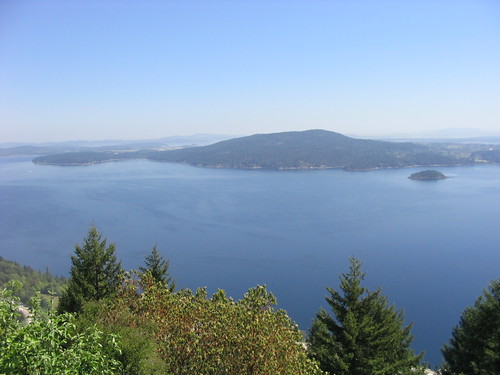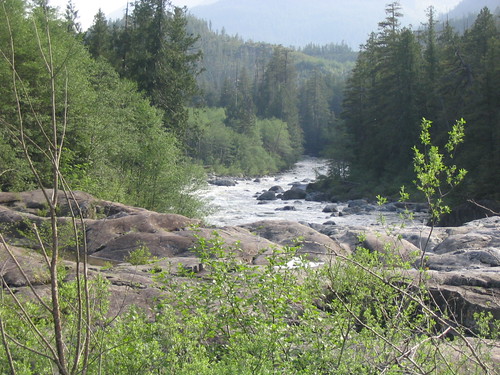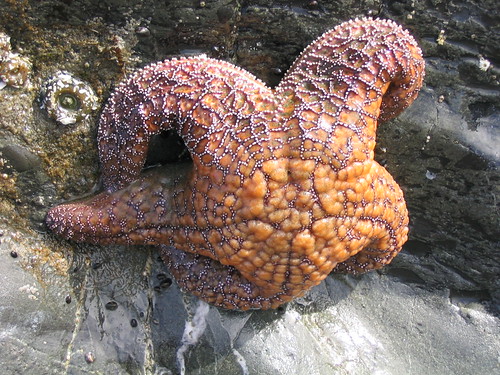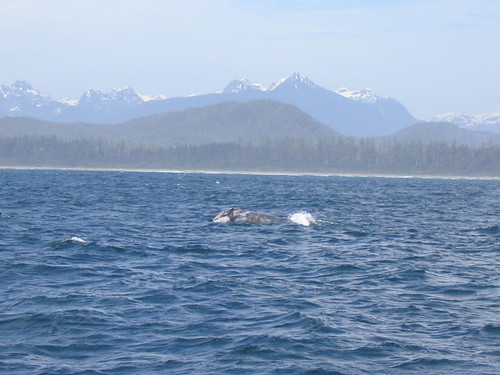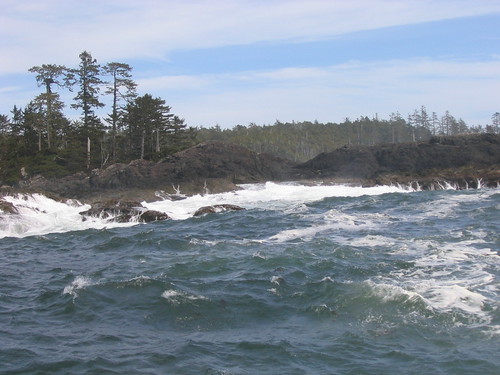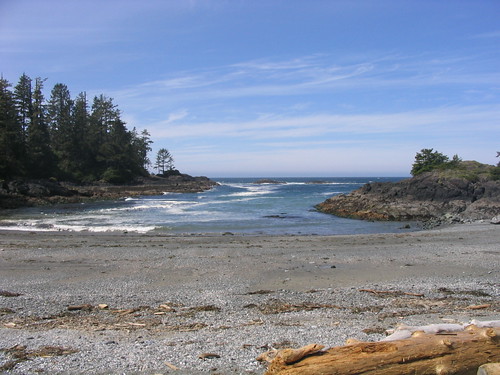I’d put the Journey of Man DVD on my Xmas list, but it seems Santa didn’t think I was good enough last year. So I ordered it for myself and finally got around to watching it this cold, rainy Easter weekend.
In brief, this documentary describes an attempt to reconstruct the human family tree and trace the migrations of human populations as they left Africa fifty thousand years ago, using cutting-edge genetics—specifically, analyzing markers on the Y chromosome, taken from many thousands of men all over the planet, hence the title.
I’d put the Journey of Man DVD on my Xmas list, but it seems Santa didn’t think I was good enough last year. So I ordered it for myself and finally got around to watching it this cold, rainy Easter weekend.
In brief, this documentary describes an attempt to reconstruct the human family tree and trace the migrations of human populations as they left Africa fifty thousand years ago, using cutting-edge genetics—specifically, analyzing markers on the Y chromosome, taken from many thousands of men all over the planet, hence the title. This is ambitious. I mean, I’ve got a couple of relatives who studied the family tree, but their research only went back about three and a half centuries. But geneticist Dr. Spencer Wells (whose research this partly is, and who wrote and hosted the documentary) did more than relate a lot of facts and theories. He actually followed the paths of these migrations, enabling him, and us, to connect with these long-ago humans and understand how they were able to make this journey.
His first stop was with the San Bushmen, the oldest human branch his research has found. They’re hunter-gatherers and have been for thousands of years, using tools and skills probably not too different from their ancestors’ (though now with some metal knives and pots). Wells mentioned a quantum leap in culture between fifty and sixty thousand years ago, a relatively sudden flowering of technology, art and possibly language, that may have been one factor in some people choosing to leave Africa. But I’m guessing the droughts caused by the then-current ice age, leading to population crashes and migrations in our ancestors’ prey (and our ancestors themselves), were probably a bigger factor. Then again, what do I know? Either way, it’s almost certain that humankind’s hunting and communication skills, curiosity and adaptability, was a big factor in their survival once they left their homeland.
The first wave of migrants eventually ended up in Australia. This is where Journey of Man took us next, and we pondered the question of why they left no archeological evidence of their journey. Dr. Wells tried, and failed, to find any mention of the journey from Africa in Australian Aboriginal oral history or art (more on this later). The next stage in the journey was Central Asia. Wells and his team visited a man living in Kazakhstan, whose blood they’d sampled some years before, to tell him he’s the direct male-line descendant of the first people to move into the region 40,000 years ago. And that the genetic markers he carries in his DNA are shared with people in Europe, most of Asia, and the Americas. He looked a bit… overwhelmed. Or maybe it all went over his head. Hard to tell, really. I mean, how are you supposed to react to news like that?
After a brief trip to Pech Merle with accompanying discussion on Cro-Magnons, we were off to visit the Chukchi, nomadic reindeer herders living in northeastern Siberia. It’s a harshly beautiful land of bare snow and ice and pitiless blue sky; hard to believe people have been living there for maybe 20,000 years. But they have; the Chukchi’s survival is due not just to their amazing survival skills but also to their physical adaptations. In a cold environment, there’s evolutionary pressure to have a stouter body, with shorter limbs and extremities, to reduce surface area and limit heat loss—just as the Bushmen’s Kalahari Desert home led to tall and slim body proportions, with bare skin for efficient sweating. Evolution also explains why my European ancestors lost most of the melanin in their skin. In the higher latitudes, with Europe’s then very cold climate, having large amounts of this natural sunblock wasn’t the survival trait it used to be in Africa: with early Europeans bundled up against the cold for most of the year and the sun lower in the sky, there was less risk of skin damage but also less vitamin D being produced in their bodies. Lighter skin meant more UV rays being absorbed by the skin, which meant more vitamin D. How fascinating is that?
But beyond the science, I found Journey of Man deeply moving, because it is a story of survival against terrible odds. And humankind did more than survive: it triumphed and prospered, creating a stunning diversity of cultures and technologies with skill, courage, and probably a lot of luck. I found my perspective broadened: for example, Wells and his team had trouble crossing the border into Kazakhstan because of the war in nearby Afghanistan (the documentary was filmed in 2002). But don’t wars and borders seem terribly arbitrary and pointless when placed against a history measured in tens of thousands of years? Sounds a bit trite, maybe, but there it is. The same could be said for racial categories. I was moved almost to tears by the ending montages of smiling faces of all the people we saw in the documentary. All of them different, all of them beautifully human. All of them, you, me, and every human currently living, cousins separated by only a couple of thousand generations.
Not everybody agrees, though. As I mentioned earlier, while in Australia, Dr. Wells tried to find out if the Aborigines had any oral history mentioning the journey from Africa. One Aboriginal artist he talked to said no, that Aborigines believe they were created right here in Australia. He was quite firm in his convictions, too, saying (in so many words) that he would always believe this. Wells was diplomatic and respectful—a lot more than I would have been, in his place.
In a way, what I’d like you to think about the DNA stories we’re telling is that they are that, DNA stories. That’s our version as Europeans of how the world was populated, and where we all trace back to. That’s our songline. We use science to tell us about that because we don’t have this sense of direct continuity. Our ancestors didn’t pass down those stories. We’ve lost them, and we have to go out and find them. And we use science, which is a European way of looking at the world, to do that. You guys don’t need that.
Kudos, Spencer. I doubt I could have said that with a straight face. As much as I respect people’s rights to their faiths and traditions, I won’t play along and pretend that any culture’s mythology is as valid and useful as science in making sense of the world. Also, I’m doing pretty well without my ancestors’ songlines, thanks very much.
Near the end of the documentary Dr. Wells visited a Navajo community in Arizona, to share his research as he’d done many times before, and ran into a similar stubborn faith. What’s interesting here is that these people were clearly educated enough to understand the science—one of them said he’d already heard of Wells, which puts him one up on me… but they had their stories and were sticking to them. Even though they noticed the faces of the Central Asian people Wells visited were a mix of almost every race on the planet—a bit of African, a bit of Caucasian, a bit of East Asian—they still wouldn’t even consider that Dr. Wells’ research was correct, that maybe the Navajo’s ancestors were originally from Africa. Their only compromise (and it was a pretty smug one) was to suggest that the journey uncovered by Wells’ research and the journey described in the Navajo creation story are in fact the same event. That science was finally discovering what the Navajo people had known all along.
Which… is a bit sad. I’ve seen this kind of thing before: when faced with science, it’s tradition that has to adapt, claim common ground, back off from literalism, perform all sorts of intellectual gymnastics. But that’s a pointless struggle, because science and faith are not equivalent. They don’t speak the same language, they don’t work the same way. As the very diplomatic Dr. Wells said, “My bias as a scientist is that I like to see evidence for things.” But I don’t have to be diplomatic, so let me say that the scientific method is not a bias, it’s a tool to prevent bias. Without it, you end up with a lot of conflicting, baseless tales that stroke the listener’s ego and make one culture the centre of the universe.
With it, you get the “DNA stories.” They don’t necessarily give you comfort, a sense of purpose, or a connection with your ancestors. They don’t come with simple narratives, clear beginnings and endings; no satisfying morals or commandments from on high. But these stories describe worlds and histories far richer and more complex than any cultural myth has ever done, and can fire the imagination like nothing else. Best of all, being based on ongoing scientific research and evidence-gathering—which beats faith (no matter how sincere) and tradition (no matter how ancient)—they constantly strive towards truth. Ideally, they’ll also cause us to strive towards truth ourselves, by questioning our own biases and convictions. To quote Dr. Wells again:
Old-fashioned concepts of race are not only socially divisive, but scientifically wrong. It’s only when we’ve fully taken this on board that we can say with any conviction that the journey our ancestors launched all those years ago is complete.
